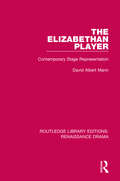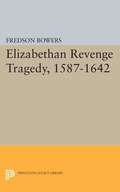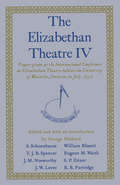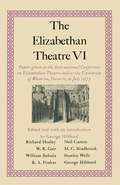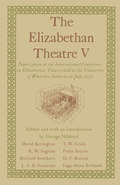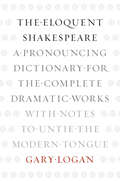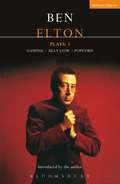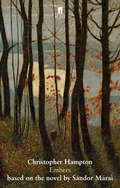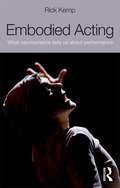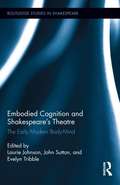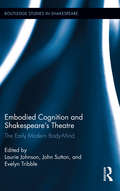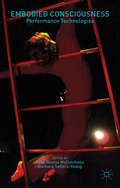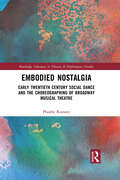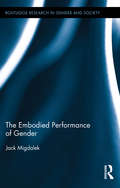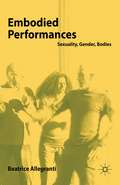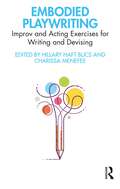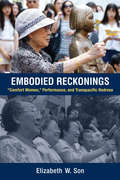- Table View
- List View
The Elizabethan Player: Contemporary Stage Representation (Routledge Library Editions: Renaissance Drama)
by David Albert MannIn this book, first published in 1991, David Mann argues for more attention to the performer in the study of Elizabethan plays and less concern for their supposed meanings and morals. He concentrates on a collection of extracts from plays which show the Elizabethan actor as a character onstage. He draws from the texts a range of issues concerning performance practice: the nature of iterance; doubling and its implications for presentational acting; the importance of clowning and improvisation; and the effects of audience and venue on the dynamics of performance. The author suggests that the stage representation of players is in part a nostalgic farewell to the passing of an impure but perhaps more vital theatre, and in part an acknowledgement of the threat the adult theatre’s growing sophistication offered to its institutional and adolescent rivals. This title will be of interest to students of Drama and Performance.
Elizabethan Revenge Tragedy, 1587-1642
by Fredson Thayer BowersA most thorough study of the Elizabethan Tragedy of Revenge, its origins, development, the ethical influence affecting it and the inter-relations of the plays.Originally published in 1966.The Princeton Legacy Library uses the latest print-on-demand technology to again make available previously out-of-print books from the distinguished backlist of Princeton University Press. These editions preserve the original texts of these important books while presenting them in durable paperback and hardcover editions. The goal of the Princeton Legacy Library is to vastly increase access to the rich scholarly heritage found in the thousands of books published by Princeton University Press since its founding in 1905.
The Elizabethan Theatre V: Papers given at the Fifth International Conference on Elizabethan Theatre held at the University of Waterloo, Ontario, in July 1973 (pdf)
by George R. HibbardThe Eloquent Shakespeare: A Pronouncing Dictionary for the Complete Dramatic Works with Notes to Untie the Modern Tongue
by Gary LoganAn actor’s deepest desire is to be understood. But when asked to pronounce such words as “chanson,” “phantasime,” or “quaestor,” many otherwise unflappable actors can be rendered speechless. The Eloquent Shakespeare aims to untie those tongues and help anyone speak Shakespeare’s language with ease. More than 17,500 entries make it the most comprehensive pronunciation guide to Shakespeare’s words, from the common to the arcane. Each entry is written in the International Phonetic Alphabet (IPA) and represents standard American pronunciations, making this dictionary perfect for North American professionals or non-native speakers of American English. Renowned Shakespearean voice and text coach Gary Logan has spent years teaching Shakespeare’s works to some of the best actors in the world. His book includes proper names, foreign words and phrases, as well as an extensive introduction that covers everything from how to interpret the entries to scansion dynamics. Designed especially for actors, directors, stage managers, and teachers, The Eloquent Shakespeare is a one-of-a-kind resource for performing Shakespeare’s dramatic works.
The Eloquent Shakespeare: A Pronouncing Dictionary for the Complete Dramatic Works with Notes to Untie the Modern Tongue
by Gary LoganAn actor’s deepest desire is to be understood. But when asked to pronounce such words as “chanson,” “phantasime,” or “quaestor,” many otherwise unflappable actors can be rendered speechless. The Eloquent Shakespeare aims to untie those tongues and help anyone speak Shakespeare’s language with ease. More than 17,500 entries make it the most comprehensive pronunciation guide to Shakespeare’s words, from the common to the arcane. Each entry is written in the International Phonetic Alphabet (IPA) and represents standard American pronunciations, making this dictionary perfect for North American professionals or non-native speakers of American English. Renowned Shakespearean voice and text coach Gary Logan has spent years teaching Shakespeare’s works to some of the best actors in the world. His book includes proper names, foreign words and phrases, as well as an extensive introduction that covers everything from how to interpret the entries to scansion dynamics. Designed especially for actors, directors, stage managers, and teachers, The Eloquent Shakespeare is a one-of-a-kind resource for performing Shakespeare’s dramatic works.
The Eloquent Shakespeare: A Pronouncing Dictionary for the Complete Dramatic Works with Notes to Untie the Modern Tongue
by Gary LoganAn actor’s deepest desire is to be understood. But when asked to pronounce such words as “chanson,” “phantasime,” or “quaestor,” many otherwise unflappable actors can be rendered speechless. The Eloquent Shakespeare aims to untie those tongues and help anyone speak Shakespeare’s language with ease. More than 17,500 entries make it the most comprehensive pronunciation guide to Shakespeare’s words, from the common to the arcane. Each entry is written in the International Phonetic Alphabet (IPA) and represents standard American pronunciations, making this dictionary perfect for North American professionals or non-native speakers of American English. Renowned Shakespearean voice and text coach Gary Logan has spent years teaching Shakespeare’s works to some of the best actors in the world. His book includes proper names, foreign words and phrases, as well as an extensive introduction that covers everything from how to interpret the entries to scansion dynamics. Designed especially for actors, directors, stage managers, and teachers, The Eloquent Shakespeare is a one-of-a-kind resource for performing Shakespeare’s dramatic works.
Elton Plays: Gasping; Silly Cow; Popcorn (Contemporary Dramatists)
by Ben EltonBen Elton's plays in one volume for the first timeGasping: ". . . an often hilarious satire on yuppiedom, advertising and corporate greed" (Daily Telegraph); ". . . the sharpest futuristic comedy since Henceforward, and the best Green comedy since The Good Life was young."(Financial Times). Silly Cow: "It has an ingenious plot. . . another perfect occasion for a Ben Elton satire on the modern world. . ." (Financial Times). Popcorn: "An enjoyable, intelligent, thought-provoking play" (Independent); "It thrills on stage precisely because it adopts the sick humour, sickening violence and downright sexiness of the Stone-Tarantino school of film-making that Elton is satirising" (Evening Standard).
Elton Plays: Gasping; Silly Cow; Popcorn (Contemporary Dramatists)
by Ben EltonBen Elton's plays in one volume for the first timeGasping: ". . . an often hilarious satire on yuppiedom, advertising and corporate greed" (Daily Telegraph); ". . . the sharpest futuristic comedy since Henceforward, and the best Green comedy since The Good Life was young."(Financial Times). Silly Cow: "It has an ingenious plot. . . another perfect occasion for a Ben Elton satire on the modern world. . ." (Financial Times). Popcorn: "An enjoyable, intelligent, thought-provoking play" (Independent); "It thrills on stage precisely because it adopts the sick humour, sickening violence and downright sexiness of the Stone-Tarantino school of film-making that Elton is satirising" (Evening Standard).
Embers: Based on the novel by Sándor Márai
by Christopher HamptonA remote 18th-century Hungarian castle is the setting for a dramatic meeting. Forty-one years after a tragic event two former friends must confront each other in a devastating bid to lay the past to rest. Betrayal, love, truth and friendship all come to the fore in this unforgettable play based on Sándor Márai's bestselling novel.Embers premiered at the Duke of York's Theatre in London's West End in February 2006.
Embodied Acting: What Neuroscience Tells Us About Performance
by Rick Kemp‘A focus on the body, its actions, and its cognitive mechanisms identifies ... foundational principles of activity that link the three elements of theatre; Story, Space, and Time. The three meet in, are defined by, and expressed through the actor’s body.’ – from the Introduction Embodied Acting is an essential, pragmatic intervention in the study of how recent discoveries within cognitive science can – and should – be applied to performance. For too long, a conceptual separation of mind and body has dominated actor training in the West. Cognitive science has shown this binary to be illusory, shattering the traditional boundaries between mind and body, reason and emotion, knowledge and imagination. This revolutionary new volume explores the impact that a more holistic approach to the "bodymind" can have on the acting process. Drawing on his experience as an actor, director and scholar, Rick Kemp interrogates the key cognitive activities involved in performance, including: non-verbal communication the relationship between thought, speech, and gesture the relationship between self and character empathy, imagination, and emotion. New perspectives on the work of Stanislavski, Michael Chekhov, and Jacques Lecoq – as well as contemporary practitioners including Daniel Day-Lewis and Katie Mitchell – are explored through practical exercises and accessible explanations. Blending theory, practice, and cutting-edge neuroscience, Kemp presents a radical re-examination of the unconscious activities engaged in creating, and presenting, a role.
Embodied Acting: What Neuroscience Tells Us About Performance
by Rick Kemp‘A focus on the body, its actions, and its cognitive mechanisms identifies ... foundational principles of activity that link the three elements of theatre; Story, Space, and Time. The three meet in, are defined by, and expressed through the actor’s body.’ – from the Introduction Embodied Acting is an essential, pragmatic intervention in the study of how recent discoveries within cognitive science can – and should – be applied to performance. For too long, a conceptual separation of mind and body has dominated actor training in the West. Cognitive science has shown this binary to be illusory, shattering the traditional boundaries between mind and body, reason and emotion, knowledge and imagination. This revolutionary new volume explores the impact that a more holistic approach to the "bodymind" can have on the acting process. Drawing on his experience as an actor, director and scholar, Rick Kemp interrogates the key cognitive activities involved in performance, including: non-verbal communication the relationship between thought, speech, and gesture the relationship between self and character empathy, imagination, and emotion. New perspectives on the work of Stanislavski, Michael Chekhov, and Jacques Lecoq – as well as contemporary practitioners including Daniel Day-Lewis and Katie Mitchell – are explored through practical exercises and accessible explanations. Blending theory, practice, and cutting-edge neuroscience, Kemp presents a radical re-examination of the unconscious activities engaged in creating, and presenting, a role.
Embodied Cognition And Shakespeare's Theatre: The Early Modern Body-mind (PDF)
by Laurie Johnson John Sutton Evelyn TribbleThis collection considers issues that have emerged in Early Modern Studies in the past fifteen years relating to understandings of mind and body in Shakespeare's world. Informed by The Body in Parts, the essays in this book respond also to the notion of an early modern 'body-mind' in which Shakespeare and his contemporaries are understood in terms of bodily parts and cognitive processes. What might the impact of such understandings be on our picture of Shakespeare's theatre or on our histories of the early modern period, broadly speaking? This book provides a wide range of approaches to this challenge, covering histories of cognition, studies of early modern stage practices, textual studies, and historical phenomenology, as well as new cultural histories by some of the key proponents of this approach at the present time. Because of the breadth of material covered, full weight is given to issues that are hotly debated at the present time within Shakespeare Studies: presentist scholarship is presented alongside more historically-focused studies, for example, and phenomenological studies of material culture are included along with close readings of texts. What the contributors have in common is a refusal to read the work of Shakespeare and his contemporaries either psychologically ormaterially; instead, these essays address a willingness to study early modern phenomena (like the Elizabethan stage) as manifesting an early modern belief in the embodiment of cognition.
Embodied Cognition and Shakespeare's Theatre: The Early Modern Body-Mind (Routledge Studies in Shakespeare)
by Laurie Johnson John Sutton Evelyn TribbleThis collection considers issues that have emerged in Early Modern Studies in the past fifteen years relating to understandings of mind and body in Shakespeare’s world. Informed by The Body in Parts, the essays in this book respond also to the notion of an early modern ‘body-mind’ in which Shakespeare and his contemporaries are understood in terms of bodily parts and cognitive processes. What might the impact of such understandings be on our picture of Shakespeare’s theatre or on our histories of the early modern period, broadly speaking? This book provides a wide range of approaches to this challenge, covering histories of cognition, studies of early modern stage practices, textual studies, and historical phenomenology, as well as new cultural histories by some of the key proponents of this approach at the present time. Because of the breadth of material covered, full weight is given to issues that are hotly debated at the present time within Shakespeare Studies: presentist scholarship is presented alongside more historically-focused studies, for example, and phenomenological studies of material culture are included along with close readings of texts. What the contributors have in common is a refusal to read the work of Shakespeare and his contemporaries either psychologically or materially; instead, these essays address a willingness to study early modern phenomena (like the Elizabethan stage) as manifesting an early modern belief in the embodiment of cognition.
Embodied Cognition and Shakespeare's Theatre: The Early Modern Body-Mind (Routledge Studies in Shakespeare)
by Laurie Johnson John Sutton Evelyn TribbleThis collection considers issues that have emerged in Early Modern Studies in the past fifteen years relating to understandings of mind and body in Shakespeare’s world. Informed by The Body in Parts, the essays in this book respond also to the notion of an early modern ‘body-mind’ in which Shakespeare and his contemporaries are understood in terms of bodily parts and cognitive processes. What might the impact of such understandings be on our picture of Shakespeare’s theatre or on our histories of the early modern period, broadly speaking? This book provides a wide range of approaches to this challenge, covering histories of cognition, studies of early modern stage practices, textual studies, and historical phenomenology, as well as new cultural histories by some of the key proponents of this approach at the present time. Because of the breadth of material covered, full weight is given to issues that are hotly debated at the present time within Shakespeare Studies: presentist scholarship is presented alongside more historically-focused studies, for example, and phenomenological studies of material culture are included along with close readings of texts. What the contributors have in common is a refusal to read the work of Shakespeare and his contemporaries either psychologically or materially; instead, these essays address a willingness to study early modern phenomena (like the Elizabethan stage) as manifesting an early modern belief in the embodiment of cognition.
Embodied Consciousness: Performance Technologies
by Jade Rosina McCutcheon and Barbara Sellers-YoungThis volume of essays combines research from neuroscience, conscious studies, methods of training performers, modes of creating a staged narrative, Asian aesthetics, and post-modern theories of performance in an examination of the relationship between consciousness and performance.
Embodied Nostalgia: Early Twentieth Century Social Dance and the Choreographing of Broadway Musical Theatre (Routledge Advances in Theatre & Performance Studies)
by Phoebe RumseyEmbodied Nostalgia is a collection of interlocking case studies that focus on how social dance in musical theatre brings forth the dancer on stage as a site of embodied history, cultural memory, and nostalgia, and asks what social dance is doing performatively, dramaturgically, and critically in musical theatre. The case studies in this volume are all Broadway musicals set during the Jazz Age (1910-1950), however, performed and produced after that time, creating a spectrum of nostalgic impulses that are interrogated for social and political resonance and meaning. All reflect the fractures or changes in the social dance when brought to the stage and expose the complexities of the embodied nostalgia – broadly interpreted as the physicalizing of community memories, longings, and historical meaning – the dances carry with them. Particular attention is focused on the Black ownership of the social dances and the subsequent appropriation, cultural theft, and forgotten legacies. By approaching musical theatre through this lens of social dance––always already deeply connected to notions of class and race––and the politics of choreography therein, a unique and necessary method to describing, discussing, and critically evaluating the body in motion in musical theatre is put forth.
Embodied Nostalgia: Early Twentieth Century Social Dance and the Choreographing of Broadway Musical Theatre (Routledge Advances in Theatre & Performance Studies)
by Phoebe RumseyEmbodied Nostalgia is a collection of interlocking case studies that focus on how social dance in musical theatre brings forth the dancer on stage as a site of embodied history, cultural memory, and nostalgia, and asks what social dance is doing performatively, dramaturgically, and critically in musical theatre. The case studies in this volume are all Broadway musicals set during the Jazz Age (1910-1950), however, performed and produced after that time, creating a spectrum of nostalgic impulses that are interrogated for social and political resonance and meaning. All reflect the fractures or changes in the social dance when brought to the stage and expose the complexities of the embodied nostalgia – broadly interpreted as the physicalizing of community memories, longings, and historical meaning – the dances carry with them. Particular attention is focused on the Black ownership of the social dances and the subsequent appropriation, cultural theft, and forgotten legacies. By approaching musical theatre through this lens of social dance––always already deeply connected to notions of class and race––and the politics of choreography therein, a unique and necessary method to describing, discussing, and critically evaluating the body in motion in musical theatre is put forth.
The Embodied Performance of Gender (Routledge Research in Gender and Society)
by Jack MigdalekNorms of embodied behaviour for males and females, as promoted in mainstream Western public arenas of popular culture and the everyday, continue to work, overtly and covertly, as definitive and restrictive barriers to the realm of possibilities of embodied gender expression and appreciation. They serve to disempower and marginalize those not inclined to embody according to such dichotomous models. This book explores the ramifications of the way our gendered, sexed and culturally constructed bodies are situated toward notions of difference and highlights the need to safeguard the social and emotional well-being of those who do not fit comfortably with dominant norms of masculine/feminine behaviour, as deemed appropriate to biological sex. The book interrogates gender inequitable machinations of education and performance arts disciplines by which educators and arts practitioners train, teach, choreograph, and direct those with whom they work, and theorizes ways of broadening personal and social notions of possible, aesthetic, and acceptable embodiment for all persons, regardless of biological sex or sexual orientation. The author’s own struggles as a performance artist, educator, and person in the everyday, as well as the findings of empirical fieldwork with educators, performance arts practitioners, and high school students, are employed to illustrate and advocate the need for self reflexive scrutiny of existing and hidden inequities regarding the embodiment of gender within one’s own habitual perspectives, taste, and practices.
The Embodied Performance of Gender (Routledge Research in Gender and Society)
by Jack MigdalekNorms of embodied behaviour for males and females, as promoted in mainstream Western public arenas of popular culture and the everyday, continue to work, overtly and covertly, as definitive and restrictive barriers to the realm of possibilities of embodied gender expression and appreciation. They serve to disempower and marginalize those not inclined to embody according to such dichotomous models. This book explores the ramifications of the way our gendered, sexed and culturally constructed bodies are situated toward notions of difference and highlights the need to safeguard the social and emotional well-being of those who do not fit comfortably with dominant norms of masculine/feminine behaviour, as deemed appropriate to biological sex. The book interrogates gender inequitable machinations of education and performance arts disciplines by which educators and arts practitioners train, teach, choreograph, and direct those with whom they work, and theorizes ways of broadening personal and social notions of possible, aesthetic, and acceptable embodiment for all persons, regardless of biological sex or sexual orientation. The author’s own struggles as a performance artist, educator, and person in the everyday, as well as the findings of empirical fieldwork with educators, performance arts practitioners, and high school students, are employed to illustrate and advocate the need for self reflexive scrutiny of existing and hidden inequities regarding the embodiment of gender within one’s own habitual perspectives, taste, and practices.
Embodied Performances: Sexuality, Gender, Bodies
by B. AllegrantiWith a companion website that includes short online film episodes, this book proposes expansive ways of deconstructing and re-constituting sexuality and gender and thus more embodied and ethical ways of 'doing' life, and offers an understanding and critique of embodiment through an integration of performance, psychotherapy and feminist philosophy.
Embodied Playwriting: Improv and Acting Exercises for Writing and Devising
by Hillary Haft Bucs Charissa MenefeeEmbodied Playwriting: Improv and Acting Exercises for Writing and Devising is the first book to compile new and adapted exercises for teaching playwriting in the classroom, workshop, or studio through the lens of acting and improvisation. The book provides access to the innovative practices developed by seasoned playwriting teachers from around the world who are also actors, improv performers, and theatre directors. Borrowing from the embodied art of acting and the inventive practice of improvisation, the exercises in this book will engage readers in performance-based methods that lead to the creation of fully imagined characters, dynamic relationships, and vivid drama. Step-by-step guidelines for exercises, as well as application and coaching advice, will support successful lesson planning and classroom implementation for playwriting students at all levels, as well as individual study. Readers will also benefit from curation by editors who have experience with high-impact educational practices and are advocates for the use of varied teaching strategies to increase accessibility, inclusion, skill-building, and student success. Embodied Playwriting offers a wealth of material for teachers and students of playwriting courses, as well as playwrights who look forward to experimenting with dynamic, embodied writing practices.
Embodied Playwriting: Improv and Acting Exercises for Writing and Devising
Embodied Playwriting: Improv and Acting Exercises for Writing and Devising is the first book to compile new and adapted exercises for teaching playwriting in the classroom, workshop, or studio through the lens of acting and improvisation. The book provides access to the innovative practices developed by seasoned playwriting teachers from around the world who are also actors, improv performers, and theatre directors. Borrowing from the embodied art of acting and the inventive practice of improvisation, the exercises in this book will engage readers in performance-based methods that lead to the creation of fully imagined characters, dynamic relationships, and vivid drama. Step-by-step guidelines for exercises, as well as application and coaching advice, will support successful lesson planning and classroom implementation for playwriting students at all levels, as well as individual study. Readers will also benefit from curation by editors who have experience with high-impact educational practices and are advocates for the use of varied teaching strategies to increase accessibility, inclusion, skill-building, and student success. Embodied Playwriting offers a wealth of material for teachers and students of playwriting courses, as well as playwrights who look forward to experimenting with dynamic, embodied writing practices.
Embodied Reckonings: “Comfort Women,” Performance, and Transpacific Redress
by Elizabeth SonEmbodied Reckonings examines the political and cultural aspects of contemporary performances that have grappled with the history of the “comfort women,” the Japanese military’s euphemism for the sexual enslavement of girls and young women—mostly Korean—in the years before and during World War II. Long silent, in the early 1990s these women and their supporters initiated varied performance practices—protests, tribunals, theater, and memorial-building projects—to demand justice for those affected by state-sponsored acts of violence. The book provides a critical framework for understanding how actions designed to bring about redress can move from the political and legal aspects of this concept to its cultural and social possibilities. Based on extensive archival and ethnographic research, the study argues for the central role of performance in how Korean survivors, activists, and artists have redressed the histories—and erasures—of this sexual violence. Merging cultural studies and performance theory with a transnational, feminist analysis, the book illuminates the actions of ordinary people, thus offering ways of reconceptualizing legal and political understandings of redress that tend to concentrate on institutionalized forms of state-based remediation.
